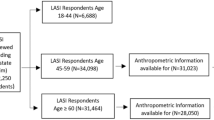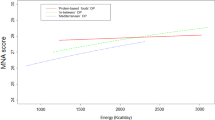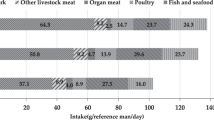Abstract
Objective: To establish the prevalence of the risk of undernutrition, using criteria similar to those used by the Malnutrition Advisory Group (MAG), in people aged 65 y and over, and to identify relationships between risk of undernutrition and health and demographic characteristics.
Design: A cross-sectional nationally representative sample of free-living and institutionalized older people in the UK (65 y of age and over). Secondary analysis of the National Diet and Nutrition Survey based on 1368 people aged 65 y and over.
Results: About 14% (21% in those living in institutions) were at medium or high risk of undernutrition based on a composite measure of low body mass index and recent reported weight loss. Having a long-standing illness was associated with a statistically significantly increased risk of undernutrition (odds ratio: men 2.34, 95% CI 1.20–4.58; women 2.98; 1.58–5.62). The risk of undernutrition increased: in women reporting bad or very bad health status; in men living in northern England and Scotland; for those aged 85 y and older; for those hospitalized in the last year, and those living in an institution. Lower consumption of energy, meat products or fruit and vegetables and lower blood measures of zinc, vitamins A, D, E and C were associated with statistically significantly increased risk of undernutrition.
Conclusion: A substantial proportion of the older population of the UK is at risk of undernutrition. High-risk subjects are more likely to have poorer health status. It is unlikely that the individuals at high risk are being detected currently, and therefore effective care is not being provided, either in the community or in institutions.
Sponsorship: This analysis was partly funded by a grant from the Department of Health. We are grateful for helpful comments from Professor MJ Wiseman and the anonymous reviewers.
This is a preview of subscription content, access via your institution
Access options
Subscribe to this journal
Receive 12 print issues and online access
$259.00 per year
only $21.58 per issue
Buy this article
- Purchase on Springer Link
- Instant access to full article PDF
Prices may be subject to local taxes which are calculated during checkout
Similar content being viewed by others
References
Beck, AM, Ovesen, L & Schroll, M (2001). A six months' prospective follow-up of 65+-y-old patients from general practice classified according to nutritional risk by the Mini Nutritional Assessment. Eur. J. Clin. Nutr., 55, 1028–1033.
Chen, C-HC, Schilling, LS & Lyder, CH (2001). A concept analysis of malnutrition in the community. J. Adv. Nurs., 36, 131–142.
Edington, J, Perkins, A & Griffin, CVB et al (2000). Prevalence of malnutrition on admission to four hospitals in England. Clin. Nutr., 19, 191–195.
Elia, M (2001). Obesity in the elderly. Obes. Res., 4, (Suppl) 244S–248S.
Elia, M (ed.) (2000). Guidelines for detection and management of malnutrition, A report by the Malnutrition Advisory Group Maidenhead: BAPEN
Finch, S, Doyle, W, Lowe, C, Bates, CJ, Prentice, A & Smithers, G et al (1998). National Diet and Nutrition Survey: People aged 65 Years and Over, London: The Stationery Office
Guigoz, Y, Vellas, B & Garry, PJ (1994). Mini nutritional assessment: a practical tool for grading the nutritional state of elderly patients. Facts Res. Gerontol., (Suppl 2) 15–81.
Holland, B, Welch, AA, Unwin, ID, Buss, DH, Paull, AA & Southgate, DAT (1991). McCance and Widdowson's the Composition of Foods, 5th edn London: Royal Society of Chemistry
McWhirter, JP & Pennington, CR (1994). Incidence and recognition of malnutrition in hospital. Br. Med. J., 308, 945–948.
Meltzer, AA & Everhart, JE (1995). Unintentional weight loss in the United States. Am. J. Epidemiol., 142, 1039–1046.
Office for Health Economics (1997). Morbidity and Mortality Rates in the UK, London: Her Majesty's Stationery Office
Pearson, JM, Sclettwein-Gsell, D, Brzozowska, A, van Staveren, WA & Bjornsbo, K (2001). Life style characteristics associated with nutritional risk in elderly subjects aged 80–85 y. J. Nutr. Health Aging, 5, 278–283.
Posner, BM, Jett, AM, Smigelski, CG, Miller, D & Mitchell, P (1994). Nutritional risk in New England Elders. J. Gerontol. A Biol. Sc. Med. Sci., 49, M123–M132.
Pullinger, J (ed.) (1999). Office for National Statistics. Social Trends 29, London: The Stationery Office
SENECA Investigators (1996). Longitudinal changes in anthropometric characteristics of elderly Europeans. Eur. J. Clin. Nutr., 50, (Suppl 2) S9–S15.
Shatenstein, B, Kergoat, MJ & Nadon, S (2001a). Weight change, nutritional risk and its determinants among cognitively intact and demented elderly Canadians. Can. J. Public Health, 92, 143–149.
Shatenstein, B, Kergoat, MJ & Nadon, S (2001b). Anthropometric changes over 5 y in elderly Canadians by age, gender, cognitive status. J. Gerontol. A Biol. Sci. Med. Sci., 56, M483–488.
Shetty, PS & James, WPT (1994). Body mass index. A measure of chronic energy deficiency in adults, FAO Food and Nutrition paper 56 Rome: FAO
Stewart, AL (1982). The reliability and validity of self-reported weight and height. J. Chron. Dis., 35, 295–309.
Stratton, RJ & Elia, M (2002). Cocurrent validity of three nutrition screening tools for use in the community. Proc. Nutr. Soc., (in press)
Wannamethee, SG, Shaper, AG, Whincup, PH & Walker, M (2000). Characteristics of older men who lose weight intentionally or unintentionally. Am. J. Epidemiol., 151, 667–675.
Weekes, CE & Elia, M (2002). Identifying patients with nutritional problems: a comparison of two screening tools. Proc. Nutr. Soc., (in press)
Wellman, NS (1994). The nutrition screening initiative. Nutr. Rev., 52, S44–47.
Willett, WC (1997). Weight loss in the elderly: cause or effect of poor health?. Am. J. Clin. Nutr., 66, 737–738.
Author information
Authors and Affiliations
Corresponding author
Rights and permissions
About this article
Cite this article
Margetts, B., Thompson, R., Elia, M. et al. Prevalence of risk of undernutrition is associated with poor health status in older people in the UK. Eur J Clin Nutr 57, 69–74 (2003). https://doi.org/10.1038/sj.ejcn.1601499
Received:
Revised:
Accepted:
Published:
Issue Date:
DOI: https://doi.org/10.1038/sj.ejcn.1601499
Keywords
This article is cited by
-
Association between the serum zinc level and nutritional status represented by the geriatric nutritional Rrisk index
Clinical and Experimental Nephrology (2024)
-
Ageing rate of older adults affects the factors associated with, and the determinants of malnutrition in the community: a systematic review and narrative synthesis
BMC Geriatrics (2021)
-
Culinary and herbal resources as nutritional supplements against malnutrition-associated immunity deficiency: the vegetarian review
Future Journal of Pharmaceutical Sciences (2020)
-
Subgrouping Poor Sleep Quality in Community-Dwelling Older Adults with Latent Class Analysis - The Yilan Study, Taiwan
Scientific Reports (2020)
-
Association of dietary approaches to stop hypertension eating style and risk of sarcopenia
Scientific Reports (2020)



